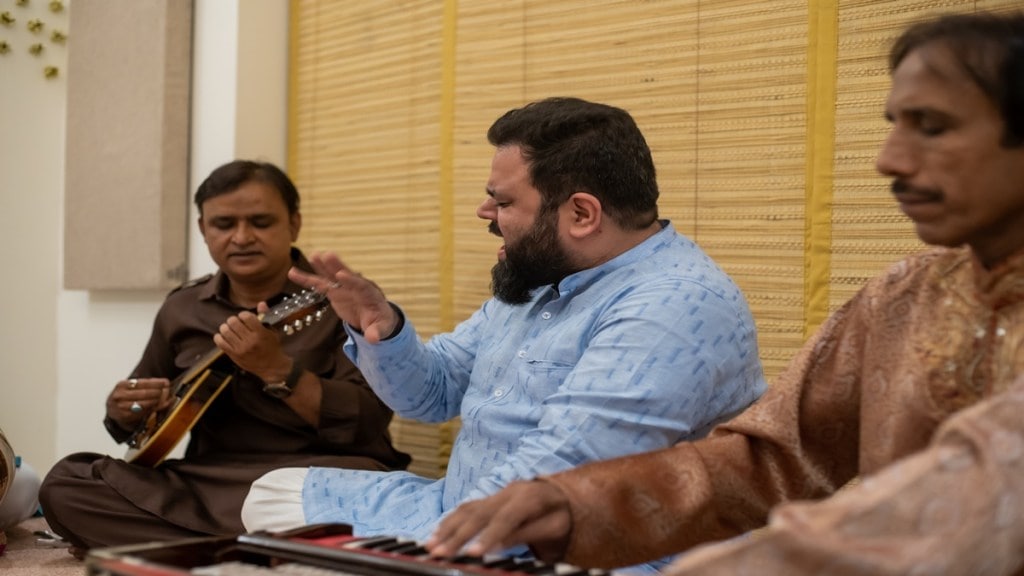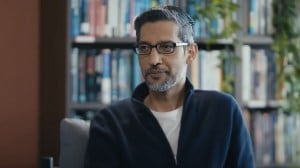By Ankur Biplav
At one of the baithaks recently organised by NaadVistaar, a Delhi-based learner-led initiative that aims to promote and preserve the ethos of Indian classical music, sitar player Iti Aham started her rendition of Raga Yaman with a 45-minute alaap.
Alaap is an essential and elaborate component of a performance where the artiste establishes the foundation of a raga through melodic exploration and improvisation.
Sadly, “nowadays, people don’t want to listen to alaap for such a long duration. They wait for the percussion instrument to start, which in this case was pakhawaj”, says Dhruv Sangari, a leading Sufi and Indian classical vocalist and a guru at NaadVistaar. Sangari aims to correct this way of consuming music.
Starting her sitar training at the age of 11 years when she was first introduced to the Khayal style of Indian classical music, Aham is a disciple of Ustad Mohi Bahauddin Dagar, who represents the 20th generation of the famed Dagar family of Dhrupad musicians.
A new generation of artistes like Aham and Sangari is engaged in the revival of Dhrupad, an ancient Indian vocal musical form, that is facing a dip in popularity.
Tracing its roots
The word ‘Dhrupad’ is derived from the Sanskrit words ‘dhruva’ (which translates into steadfast) and ‘pada’ (which translates into verse), originating in the medieval period of Indian history. It finds its roots in the Vedic chanting traditions and has close ties to religious and spiritual practices.
Ancient texts mention Dhrupad as an integral part of the temple rituals, where it was performed as a devotional offering to the deities. It was also a preferred style of singing in the royal courts of north India during the reign of the Mughals. Over time, Dhrupad evolved into a refined and intricate art form, blending elements of poetry, spirituality and classical music.
Dhrupad is characterised by its slow and measured pace, with a strong emphasis on maintaining the purity of the notes. It focuses on the exploration and elaboration of the ragas and emphasises the depth and resonance of the human voice.
As time passed, Dhrupad went through several transformations while retaining its core essence. Notable figures like Swami Haridas and Miyan Tansen played instrumental roles in shaping and popularising Dhrupad. However, with the advent of other forms of classical music like Khayal, Dhrupad faced a decline in popularity during the 18th and 19th centuries. Yet, it managed to survive due to the dedicated efforts of a few stalwart musicians and scholars who recognised its intrinsic value.
In the 20th century, the resurgence of Dhrupad began, thanks to the efforts of legendary Dhrupad exponents such as Ustad Nasir Aminuddin Dagar and Ustad Zia Fariduddin Dagar. They not only performed extensively but also trained a new generation of Dhrupad vocalists, ensuring the continuity of this ancient art form.
Sonic diversity
Over time, synthesisers and electronic sounds have reduced the human ear’s capacity to listen to finer music, feels Sangari. “We are not monkeys living in the cage. We are human beings. To understand the value of our ancestral heritage is key to both our present and our future,” he adds, emphasising the importance of coming back to sonic diversity which he feels has been lost somehow.
The loss of sonic diversity is a concerning phenomenon that can be observed in various realms of music, including Indian classical music. It refers to the diminishing range of unique and distinct sounds, timbres and musical expressions that were once present in a particular musical tradition or culture.
“These sounds or music have diminished the capacity of the human ear to be able to hear finer sounds, very fragile sounds, the notes between the notes,” adds Sangari.
When quizzed on how it can be brought back, he says, “It can come back by practising, learning, listening to other genres of music where scales that are used are not just on the universal 440-megahertz frequency.”
“How did musicians in older generations use to tune instruments?” asks Sangari, adding: “They did it just by using their ear. They had an oral memory or a sonic memory of the scale.”
Learning landscape
With NaadVistaar, Sangari aims to create an eclectic space for the learning and imparting of music. “The idea was not to have a typical space, like a tuition model, where teachers whose training and methods are themselves not complete or replete with the traditional experience,” says Sangari, also known as Bilal Chishty Sangari, who learnt music under Delhi Gharana’s Ustaad Iqbal Ahmed Khan and later also went on to learn under the legendary Pakistani qawwali maestro Ustad Nusrat Fateh Ali Khan.
“Our whole understanding is to create a space where everybody is welcomed. They can experience, learn and absorb the way Indian classical music should be,” says Sangari.
With this organisation, they also aim to provide sustainable livelihood to hereditary musicians. “To spread, preserve and promote the oral intangible musical heritage are the strongest parts of our mission,” adds Sangari.
Commenting on the guru-shishya parampara, which translates in English to a teacher-disciple tradition and is a fundamental aspect of Indian music, particularly in the realm of Indian classical music, Sangari says even in Europe and other parts of the world they have systems of ‘journeymanship’ where art, craft, music, etc, are passed on from generation to generation. “Now some are in a professional capacity while others are in a homely setting. The ones at home—children—are taught to read, write, sing, play, cook, clean and do everything that they will need in their life,” says Sangari, equating it with the gharana system of music.
Typically, gharanas represent a distinct lineage or school of musical thought and practice. But Sangari says that it doesn’t always necessarily mean ‘style’. “Gharana literally means a ‘house of music’. Style is there but even within one gharana you can have two artistes with hugely different styles,” says Sangari, adding that in the gharana system of education, a child starts to absorb the manners and activities from a very young age.
Sangari also believes that age should not be a bar when it comes to learning an art form. “Even a three-month child who can’t really learn can come here and start listening to music,” says Sangari who emphasises the importance of listening to good music. “When the child comes and listens to this, sometimes they automatically want to listen more or even learn. And that’s when the next step of learning music comes in,” he adds.
Talking about Bollywood or the Mumbai film industry, the maestro says that though he believes it is suitable for commercial work, unfortunately, the percolation has been very negative for the preservation of classical music. “For example, if you go to a remote village in Rajasthan and request a local artiste to sing something, he or she will most probably start with a Bollywood number because they assume that you want to listen to that,” says Sangari, whose worry is that the living practitioners of these songs (folk music) would be gone in maybe a few generations. “All we would be left with will be their YouTube videos or archives,” he says.
“We want to examine the inter-connectivity between art, expression and music. And then, of course, we want to do research publications, record and also make a recording label. We believe that children should come back to learn this heritage which is such a vital part of our identity and culture,” adds Sangari.








